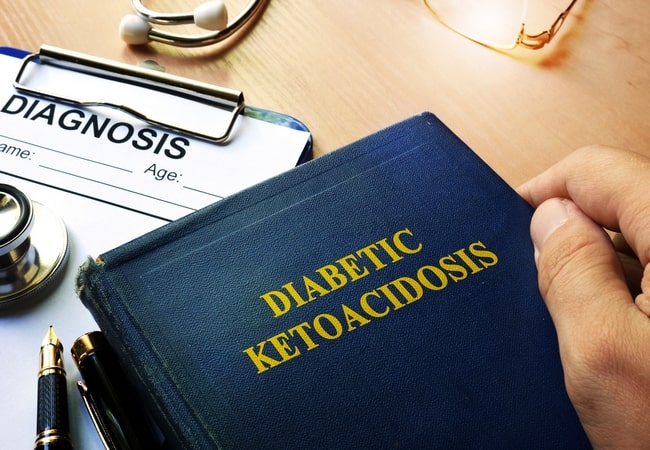Diabetic Ketoacidosis (DKA) Definition:
Diabetic ketoacidosis is a medical emergency in which hyperglycemia is associated with metabolic acidosis and hyperketonaemia principally in people with type-l diabetes.

Cardinal Features of Diabetic Ketoacidosis (DKA):
It includes-
- Hyperglycaemia,
- Metabolic acidosis,
- Hyperketonaemia.
Nursing Management of Diabetic Ketoacidosis (DKA):
- Vital signs: blood pressure, pulse, respirations, pulse oximetry, level of consciousness, temperature.
- Hourly BSL (blood sugar level) until ketones have disappeared, then 2 hourly. If BSL falls rapidly, 1/2 hourly checks may be necessary.
- Hourly ABG to monitor pH, bicarbonate and potassium until pH is above 7.10 then 2 hourly until pH is above 7.30 or bicarbonate above 15.
- Insertion of an arterial line advised due to frequent blood sampling.
- Insertion of a PICC (A PICC line is a thin, soft, long catheter (tube) that is inserted into a vein in the arm, leg or neck.) line is useful for the number of infusions
- Patient nil by mouth until acidosis is reversed. Acidosis can cause nausea and vomiting. Food intake could aggravate nausea and vomiting, increase BSL and make it difficult to titrate dextrose infusion to BSL.
- Fluid replacement: The fluids will replace those the patient lost through excessive urination, as well as help dilute the excess sugar in the blood.
- Electrolyte replacement: Electrolytes therapy through a vein to help keep the heart, muscles and nerve cells functioning normally.
- Insulin therapy: Insulin reverses the processes that cause diabetic ketoacidosis. In addition to fluids and electrolytes, patient should receive insulin therapy usually through a vein. When the blood sugar level falls below 240 mg/dL(13.3 mmol/L) and the blood is no longer acidic, stop intravenous insulin therapy and resume normal insulin therapy.
- Assess fluid status: jugular venous pressure, peripheral perfusion, capillary refill, mucous membranes, pulse rate, urine output.
- Monitor other electrolytes, urea, and creatinine 4 hourly,
- Consider insertion of urinary catheter.
- Strict fluid balance.
- Urinalysis. Check urine for ketones 2-4 hourly if catheterized or every portion voided. Be aware that it takes longer for ketones to disappear than for hyperglycemia and acidosis to resolve. Check for glucose.
- Insertion of a nasogastric tube if patient is vomiting.
- Provide oral hydration with ice chips and frequent oral hygiene.
- Provide comfort measures and manage pain.
- Give reassurance to relieve anxiety.
Complication of Diabetic Ketoacidosis (DKA):
It includes-
- Cerebral edema – due to Rapid reduction of blood glucose & Use of hypotonic fluids &/or bicarbonate,
- ARDS,
- Thrombo-embolism,
- DIC,
- Acute circulatory collapse.

Maria Khatun Mona is a Founder and Editor of Nursing Exercise Blog. She is a Nursing and Midwifery Expert. Currently she is working as a Registered Nurse at Evercare Hospital, Dhaka, Bangladesh. She has great passion in writing different articles on Nursing and Midwifery. Mail her at “maria.mona023@gmail.com”
